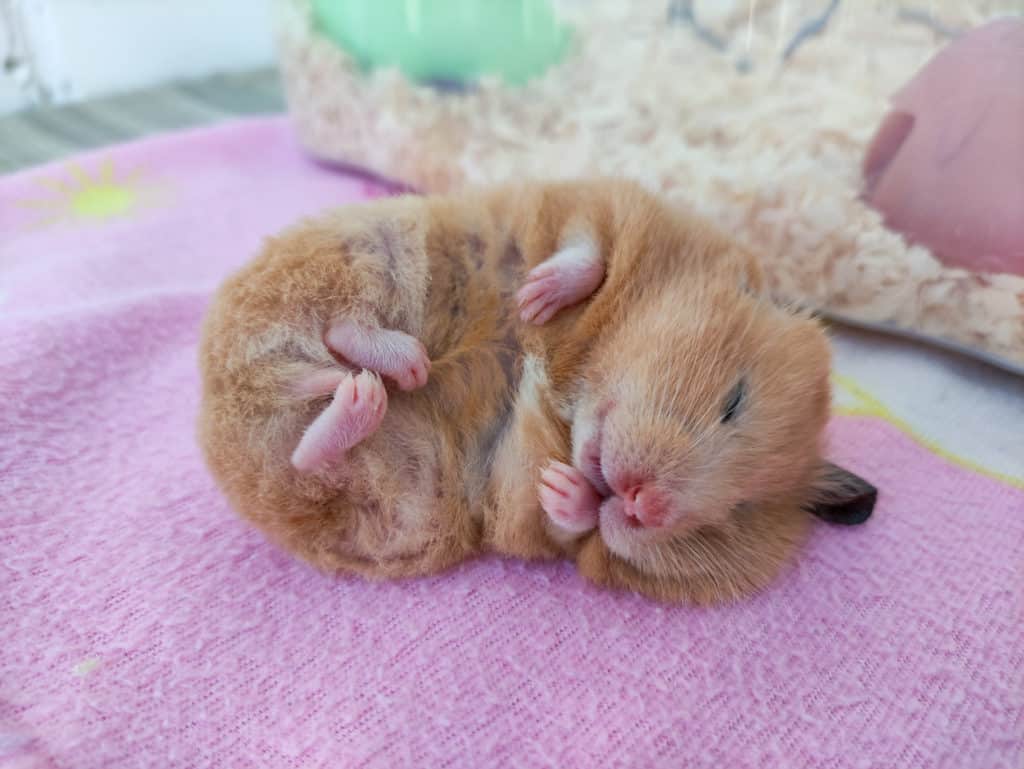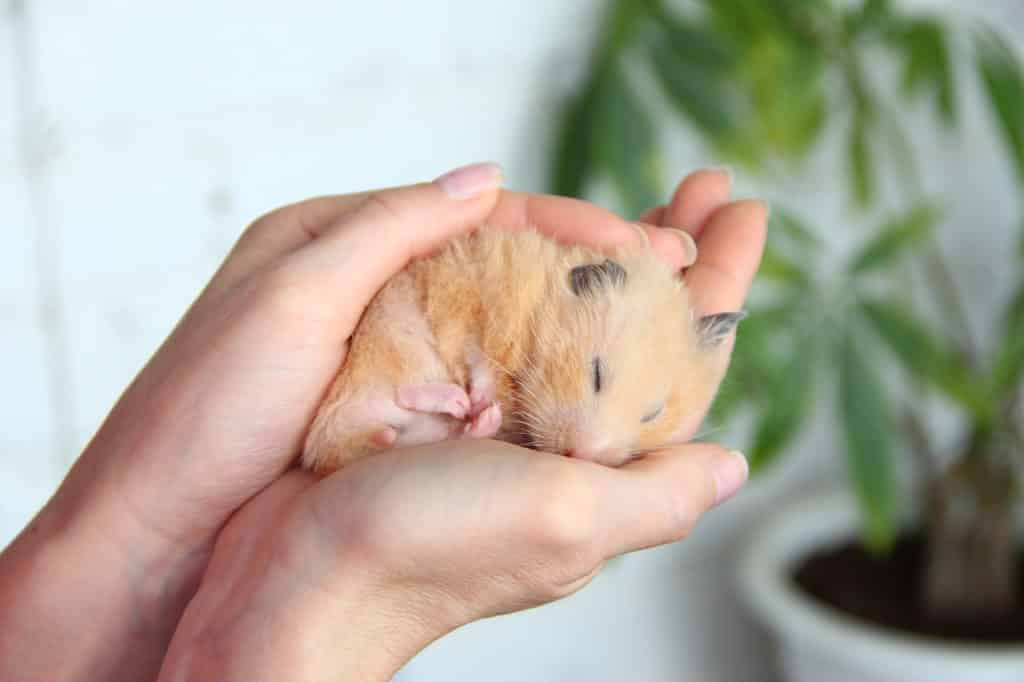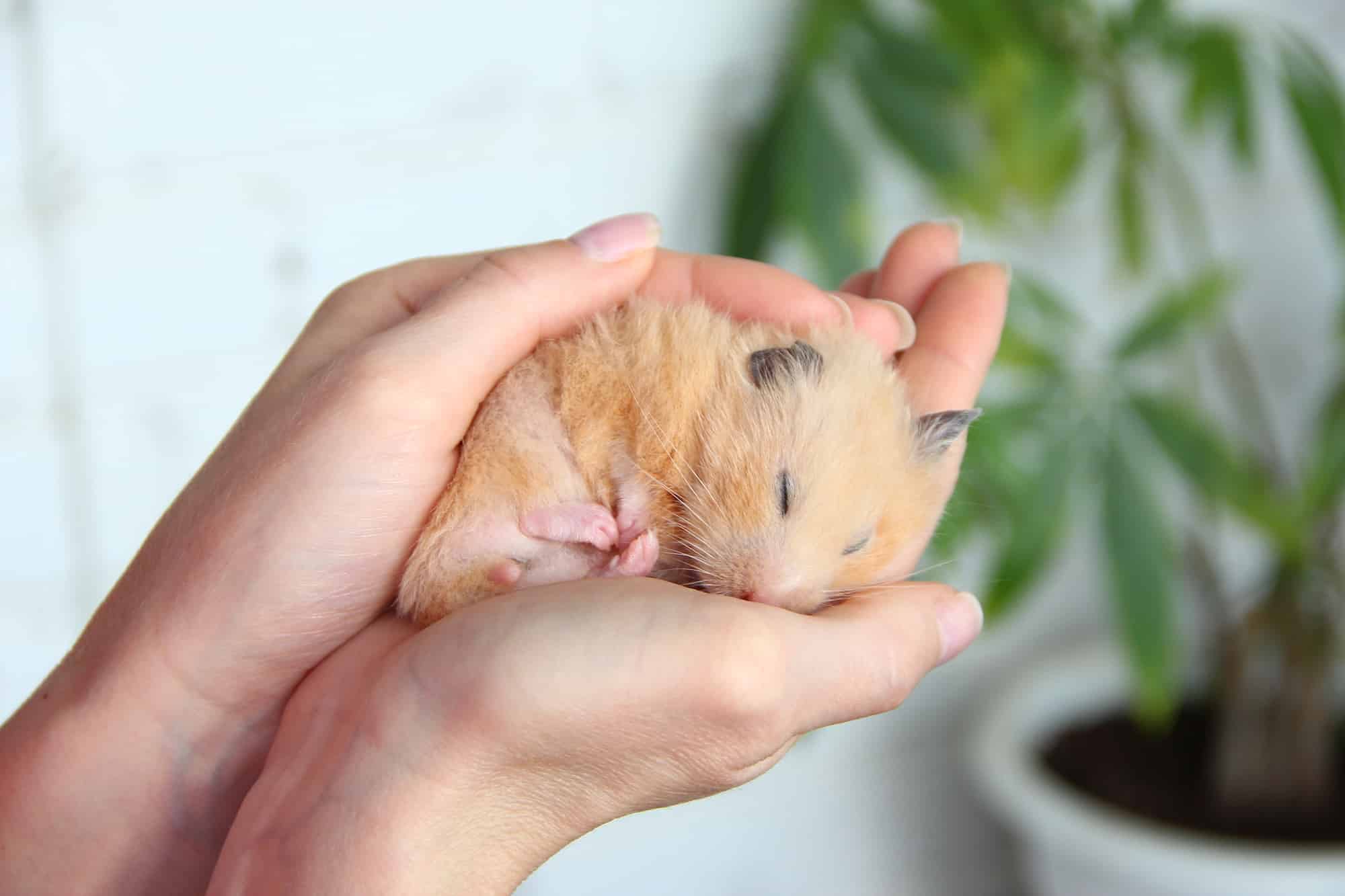Hamsters are not nocturnal animals (active at night). They are not diurnal (active during the day) either.
But wait, if they are neither nocturnal nor diurnal, what are they? Hamsters are crepuscular, i.e., they sleep during most parts of the day and the night. They become active only during the twilight hours of dawn and dusk. This is the time that wild hamsters go out to forage food.
Can your pet hamster’s sleeping habit affect you?
Weekends and holidays always bring joy, regardless of what your profession is. After working hard for five or six days a week, the weekend is the time that you have left to enjoy with your family. So, if you own a hamster and consider him family, it wouldn’t be surprising if you want to spend some time with him on the weekend. But alas! Your hamster has no weekend. He sleeps throughout the day, every single day.
So, it can be frustrating for you when you’re deprived of the joy you have looked forward to, the entire week. Therefore, you may be tempted to wake your hamster. But you know it would only end up annoying or scaring him. So, you wait until sunset for your hamster to wake up. But after waking up at sunset and playing for some time, your hamster might return to sleep at night, even if they are only small naps. Then, he would wake up at sunrise once again and be active for some time before returning to sleep once again.
Your hamster’s weird sleeping habits might be frustrating for you. When you are awake, he is asleep, and when you are asleep, he becomes active and makes noises that might wake you up. But do you know why hamsters are crepuscular? Why do they have this weird sleeping habit, unlike dogs and cats, which are active throughout the day?
Why are hamsters crepuscular?
An animal’s sleeping habits depends on two factors:
1. The ability of its body to adapt
2. Its role in the ecosystem – Predator or Prey?
Now that we know what these two factors are, let’s find out how these two factors affect a hamster’s sleeping schedule.
Why do hamsters sleep during the day?
Wild hamsters live mostly in Europe, Asia, and the Middle East, where days can be extremely hot. If they go out to forage for food during the day, they will lose a lot of energy due to the hot weather. So, they sleep throughout the day in their burrows. Since their burrows are located under the earth’s surface, the temperature there will be a lot lower than on the surface during the day. Therefore, by sleeping in their burrows during the day, hamsters can conserve a lot of energy.

Moreover, a hamster cannot see that well in bright light. The pupils of human beings have evolved to adjust the amount of light that enters the eyes (Source: The Conversation). So, we can see very well in bright light and dim light. But a hamster’s pupils cannot do that as effectively (Source: First hamster). So, they cannot see as well in bright light as in dim light.
As you probably already know, a hamster has poor eyesight. Even in dim light, a hamster can see only a few inches past his nose. So, in bright light, he becomes almost entirely blind. Therefore, if he goes out to search for food during the day, he is at a severe disadvantage compared to many predators, which can see very well during the day.
In addition to that, most predators are highly active during the peak hours of brightness (midday) or darkness (midnight) (Source: Treehugger). So, if weak prey animals, like hamsters, go out during the day to search for food, they have a higher risk of being hunted. But if they go out after the sun has set, it increases their chances of survival tremendously because the predators that hunt during the day cannot see that well during this time. So, even if a predator spots them, they can easily hide or escape. So, hamsters tend to sleep during the day and start searching for food after the sun has set.
By now, you might be thinking, “Okay, I understand why hamsters have to sleep during the day. But why do they have to sleep at night too?” Well, read on, and find out.
Why do hamsters sleep at night?
Wild hamsters live in hot arid regions. In these regions, days can be extremely hot. At the same time, nights can be equally cold as well.
Since a hamster cannot regulate his body temperature as effectively as human beings, he cannot handle colder temperatures. Therefore, if he stays out of his burrow at night, he might catch a cold, which can soon lead to pneumonia that can kill him. Therefore, hamsters return to their burrows to sleep during a part of the night.
The optimum living temperature for many hamster breeds is 18 to 24°C (Source: Animals.mom). A hamster’s body might prepare to hibernate if the temperature drops below this point. So, it is safer to stay in their burrows during the night because, even if it gets colder and they end up hibernating, they will not be eaten by predators.
Moreover, many nocturnal predators are active at midnight, when darkness is at its peak. At daybreak, they would be tired of hunting throughout the night and hence, would return to sleep. Other predators would just be waking up to prepare for hunting during the day. So, by sleeping at night time and returning to forage for food at daybreak, hamsters have a very less chance of being hunted.
Now you know why hamsters are crepuscular.
Are all hamsters crepuscular?
There are 24 species of hamsters (Source: Livescience). Of these, the most famous ones are the Syrian hamsters (also known as golden hamsters or teddy bear hamsters) and dwarf hamsters (Chinese hamster, Russian hamster, and Roborovski hamster). Most of these hamster species are known to be crepuscular.
Syrian hamsters, however, could be an exception. According to experiments, golden hamsters (Mesocricetus auratus) that live in laboratories are nocturnal. However, female hamsters of the same species in the wild are known to be diurnal (Source: PubMed). So, as pets, Syrian hamsters could be diurnal, nocturnal, or crepuscular.
Can hamsters see in the dark?
Hamsters are crepuscular creatures whose eyes have adapted to dim light. So, just like they cannot see in bright light, they cannot see in complete darkness either.
Our hamster guide can help you understand your hamster better. Check it out here -> Smallpetgenie’s hamster guide.
Hamsters’ crepuscular nature – An advantage or a disadvantage?
Hamsters being crepuscular may be advantageous for most people. If you are like most people, you may leave for work in the morning and return home by sunset. And that’s exactly the time when your hamster would wake up and become active. So, you can play with your hamster for some time before he returns to sleep again.
But if you aren’t like most people and have odd working hours, you may find your pet hamster sleeping when you return from work. So, you may be tempted to wake your hamster up to play with him. But hamsters are timid creatures that can get scared easily. And getting scared can stress them and affect their health negatively. So, if you decide to wake your hamster up, you should do so without scaring him.
How to wake a sleeping hamster without scaring him?
You can use several methods to wake your sleeping hamster without scaring him.
- Create the right lighting – Hamsters are crepuscular, i.e., they are most active at dawn and dusk, when it is neither too bright nor too dark. So, to wake your sleeping hamster, create the right conditions first. Start by dimming the light in his room.
- Create the right temperature – Hamsters sleep when it is cold and wake up when it gets hot (Source: Wikihow). So, to wake your hamster, increase the room’s temperature slowly.
- Talk softly – Hamsters are intelligent little animals that have excellent hearing abilities. So, if you talk to your hamster every time before you pick him up, he will start to recognize your voice. But regardless of whether you’ve trained your hamster to recognize your voice or not, just go near your hamster and talk to him softly or start humming slowly to wake him up.
- Jiggle the food bowl – Hamsters have good cognitive abilities. So, with time, they will learn to associate certain sounds with certain events. So, your hamster will learn to associate the sound of his food bowl (jiggling) with food. Therefore, you can jiggle his food bowl lightly to wake him up.
- Avoid loud sounds – Hamsters can hear even very faint sounds that humans cannot. So, if you don’t want to scare your hamster while waking him up, walk slowly towards his cage without making loud noises.
- Use a treat – Hamsters have excellent smelling abilities. So, if you want to wake your hamster, take your hamster’s favorite treat and place it inside the cage. The smell of his favorite food will soon wake your hamster up.
- Blow gently – If all the above methods did not help, start blowing in his face gently and increase the intensity slowly.
- Tap on his cage lightly – If your hamster is a sound sleeper and still hasn’t woken up, you can gently tap on his cage. The slight sound and vibration will wake him up. But don’t tap too hard or shake his cage too much. That might scare him.
- Never poke him – Never poke your hamster to wake him up. If you do so, he will most certainly be scared and get defensive when he wakes up. Then he won’t be in the mood to play. He might even bite you if you try to pick him up.
These tips might help you wake your hamster up occasionally. But what if you want him to wake up earlier every day? Keep reading and find out.
Can you get your hamster to sleep at night and be active during the day?
First of all, you should remember that your hamster is a crepuscular creature. Just like diurnal animals that are awake during the day and nocturnal animals that are awake during the night, hamsters have developed their sleeping habit through thousands of generations of evolution.
So, forcing your hamster to change his sleeping habit may end up affecting his health. Therefore, use the following method with caution. You cannot and should not make him a diurnal or nocturnal creature. At most, you can use the following procedure to make your hamster wake up an hour earlier. But that’s it. Let’s now look at the procedure.
- Keep a record of when your hamster wakes up. Spend a week tracking when he sleeps and when he wakes up.
- Once you figure out when he regularly wakes up, feed him the exact moment he wakes up. Do this for a week. By now, your hamster would have gotten used to his feeding schedule. He would also know that food would be ready when he woke up. In other words, when the food is ready, he would get ready to wake up.
- Now move the feeding time a fifteen minutes earlier. Wait until your hamster wakes up 15 minutes early. Then give him one week to get used to the new schedule.
- Repeat step 3 three times so that your hamster wakes up one hour earlier than his initial schedule.
- Follow the new schedule.
Similar to slowly changing the time when you give food to your hamster, you can also adjust the lighting in the room to wake your hamster up early.
Summary – Key Takeaways
Hamsters are crepuscular creatures. They are neither diurnal (active during the day) nor nocturnal (active at night). They are mostly active during the twilight hours of dusk and dawn. Evolution has shaped hamsters to be crepuscular creatures due to three main reasons:
- Hamsters are prey animals. So, they have to protect themselves from predators, most of whom are active during the day or at night.
- Their eyes have adapted to see in dim light. They can neither see in total darkness nor if it is too bright.
- Their bodies cannot regulate temperatures effectively. So, they cannot tolerate extreme temperatures – too hot (day) or too cold (night). Therefore twilight hours, when it is neither too hot nor too cold, are apt for hamsters to forage food.
While waking a hamster often can affect his health, every pet owner might want to wake the hamster occasionally to play with him. When you want to wake your hamster, use one or more of the following methods:
- Create the right lighting
- Create the right temperature
- Talk softly
- Jiggle the food bowl
- Avoid loud sounds
- Use a treat
- Blow gently
- Tap on his cage lightly
- Never poke him



